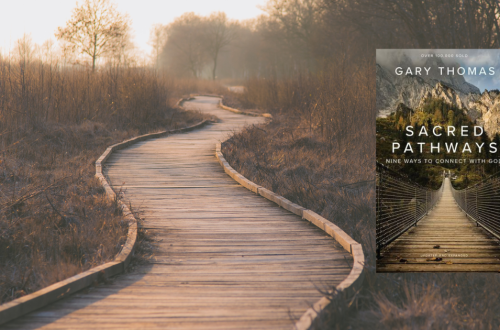
Sacred Pathways: Nine Ways to Connect with God
Part One
Recently I found a little book called Sacred Pathways: Nine Ways to Connect with God.
I love anything that helps me connect with God. To me Bible study, quiet time, prayer—it’s all about connecting with God. Anxiety disconnects me. I go inside myself and don’t always connect with God, who is more than happy to come when I call and hold my hand and guide me back to calm. So, I thought, nine ways to make this connection. I can use that.
Gary Thomas wrote this book, and the premise is that he’s discovered nine ways a person gets close to God. He is thinking in terms of quiet time and personal worship. This is not a call for free-for-all corporate worship based on what feels good. No, it’s paying attention to how we interact with God the best and making use of those methods.
But Thomas is careful. He suggests we can learn from each method, and he points out the cons to each method. Again, we’re dealing with feelings here that can drag us into a journey of Self and not of God. We want to keep the focus on God.
I’m going to go ahead and spoil the whole book for you by listing the nine ways and giving you a small explanation for each one. When I finish, maybe you’ll know which ways work best for you.
The Naturalist
The first is the Naturalist. This is the person who interacts best with God in the outdoors. A walk in the park, a hike in the hills, vacations in exotic locales—the naturalist sees the truths of God more clearly when outside surrounded by creation.
The con for this one is obvious. We are seeing God in creation, not seeing creation as God. Everything out there is under God’s authority, and it is separate from him. Idolatry through the ages focused on worshiping creation. Let’s not do that here.
Some of the pros for seeing God in the natural world is that many of the spiritual truths in the Bible are stories about nature (Jesus did this more than once), so if we are in nature, we will also see some of these lessons. Also, spending time in nature often coincides with rest. Even a hike can be mentally restful. Sitting in a park is physically restful. Observing over doing—it’s restful, and God desires for us to rest sometimes.
The Sensate
The sensates use their senses to draw near to God. They are moved by the taste of communion, the sounds of a church service, the sight of Christian art. Ezekiel, the Biblical prophet, has many encounters with God where he mentions his senses—eating a scroll, hearing wings like a roar, seeing many unusual sights in his visions. It seems clear this man, at least, experienced God through sensual experiences.
Some churches use incense, and we know the Tabernacle and Temples included special incense. Some of the formulas were forbidden for anyone else to use. The Temple was to have a specific smell that no place else on earth had. That’s kind of cool, especially since we now know that smells are one of the best memory triggers. God already knew that, of course.

There are cons to this. I’ve been in churches where the light show and the loud music and the fog machine took over. It’s easy for the experience to become all about stimulation and not about God. We use the senses to slam home the lessons God wants for us. They are not the lessons in themselves.
And of course, like the naturalist, the sensual experience can become an idol. Sometimes quite literally. We don’t bow to the representations of truth, even if created by an artist who touches our soul. We bow to the Truth and never anything less.
The pros to the sensate experience of God is the memory thing. When we engage our senses, we remember. Quiet time can be bland sometimes, and one day runs into the next. But what if I had a book of Christian art to use with certain Bible passages? What if I ate a Passover dinner one year while reading about the Exodus? What if I listened to a passage of Scripture set to music? Ah, suddenly the perspective is a little different, and I am making long-lasting connections.
The Traditionalist
The traditionalist likes history. Ancient worship styles, liturgy, anything connecting a person to the myriad of believers in times past—this is what feeds the traditionalist.
There is an uptick in orthodox, liturgical worship in the past few years. In a world that seems to spin in chaos, the solidity of tradition is a balm. I admit I have traditionalist tendencies. A few years ago I changed to a church with rituals, traditions, liturgies, and I find great peace there. My anxious soul likes the anchor of the ages. (This one can also be closely tied with the sensates, as more historic worship often has very visual, sense-driven rituals, maybe because fewer of those earlier believers could read, so they needed other ways to remember and make connections.)
The cons for the traditionalist, according to Thomas, include serving God, through rituals and liturgy, without KNOWING God. (Think Pharisees.) Also, religion can become an excuse for not caring about people. The book of Amos records God saying he hates festivals and sacrifices when those who use them don’t seek justice for those who need it. And, of course, there is a tendency to judge. Like the Pharisees, we can let the minutiae get in the way of love, and we compare our worship to that of others.
This one is the hardest to explain in the setting of personal worship, so I’m going to let Thomas do it. If you already know you’re a traditionalist, snag the book (it’s short and inexpensive) to get a better idea for this. I’ll give you one—praying at set times, like morning or evening prayer, is a very traditionalist thing to do. I wrote a post on life rhythms, and I think the traditionalist would approve of such a life.
A pro for traditional worship is that it creates a tried-and-true framework. It is easy to give over a little truth here, a little there, and to let the world shift what we know is true. Within a framework there is some safety that can keep us from wandering too far from center.
The Ascetic
John the Baptist was ascetic. These are the people who find connection to God through simple living, aloneness, fasting, and similar practices. They work hard and live with little. They can be strict, but this is to minimize distraction and to focus on God.
Many monks through the ages have been ascetic. God is foremost, and everything else—everything—gets second place. Some of the disciplines the ascetic practices include silence and solitude.
Obedience is also highly valued to the ascetic. Following the speed limit, Thomas said, which many of us fudge, might be a big deal to an ascetic, who wishes to honor God and put Him first in all things.
Some of the pitfalls for the ascetic is using sacrifice to gain God’s favor, as well as thinking God judges one’s value on how simply one can live. As in most practices, there is a tendency to compare ourselves with those around us, and ascetics can fall into this trap. Sacrifice and hardship simply for the sake of sacrifice and hardship, while losing sight of honoring God through all of it, can be a problem for the ascetic.
The biggest pro to the ascetic lifestyle is the intentional lack of distractions. According to Thomas, all of us can learn from solitude and stillness. In a world where we are expected to take in information every moment of every day, the ascetic has some skills in living beyond that that not all of us share. For some, focusing on God is easier in a life centered on the spiritual and not the physical or social comforts of the world.
Aren’t there more?
That’s four of the nine, and the rest are in another post. Although I’m giving away a lot in this set of posts, I’m certainly not giving it all away. The book has questions to help you determine your style, Biblical examples of each of these styles, and many specific ways to worship using each style. Trust that I haven’t done justice to what Gary has written.
Can’t wait to see the rest? Here are all nine and the briefest description. Now head to the second half to learn more.
- Naturalist: Let me be outdoors
- Sensate: Let me experience
- Traditionalist: Let me remember
- Ascetic: Let me be alone
- Activist: Let me conquer
- Caregiver: Let me care
- Enthusiast: Let me celebrate
- Contemplative: Let me feel
- Intellectual: Let me think
Tune in to the next post to read about the final five of the nine sacred pathways from Gary Thomas’s book.




